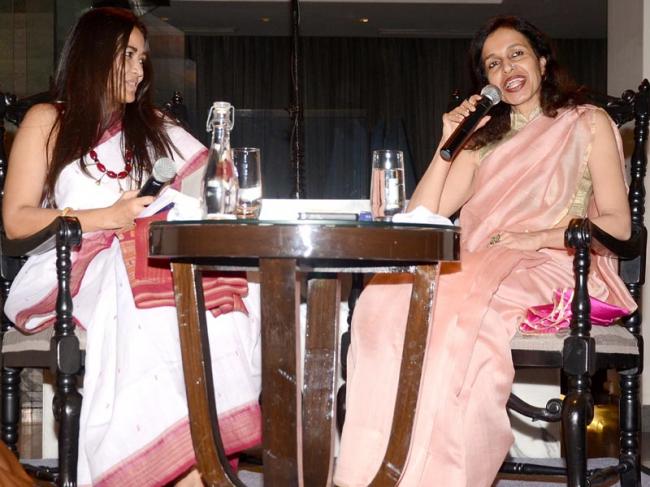NITN | @notintownlive | 02 Nov 2019, 01:42 pm

Writer and academician Madhavi Menon was in Kolkata recently to speak about her new book 'Infinite Variety: A History of Desire in India'. From Lord Ayyappa to various forms of desires that centres around sexuality, the nearly hour-long discussion made An Author's Afternoon event a fascinating journey for the audience. IBNS correspondent Supriyo Hazra brings excerpts of the conversation at the event presented by Shree Cement Ltd and organised by the Prabha Khaitan Foundation in association with Taj Bengal, Kolkata.
How do we identify desire today?
It is an obvious question that you have asked to begin the session- that how do we understand desire. The sub-title of my book is 'A History of Desire in India'. So, it's a question that everyone wants to begin with and I must say that it's always a very tricky question for me. Everyone asks me what is the theme you want to write about in the book. Actually, in my book, I have pointed out that desire is actually not a thing. So, it is an impossible question to answer when someone asks me what is a desire? In this book, I have 20 short chapters and each of them deals with an everyday location where we might encounter desire. I have chapters dealing with hair to education and even suicide. So, I must say that one of the arguments I want to make in the book is that desire is everywhere around us. It is present there all the time. We are interacting and encountering it every moment. We do that even not realizing it properly. My argument is that even when we are not thinking about it, we are in the middle of desire. From the way we dress up to the way we speak, everything is attributable to the idea of desire.
.jpg)
You have reference to God of Love Kama in your book. Speak something about it?
The irony is when we think about desire today, we largely think about ideas of western scholars. So, we always think in terms of bodies. We cannot think about desire outside the body. Infact, this idea comes very easily to us. What fascinated me while writing this book was that we have a long and deep tradition attached to religion where desire has been seen as a thing that does not have a body. It is completely opposite to the common sense situation with which we are occupied today. Speaking on Kama, the story associated with him tells that he was deputed with the task of waking up Shiva from his state of long meditation so that he could get together with Parvati and have a child who can kill the demon. Kama woke up Shiva by shooting an arrow at him. Shiva became furious and burned down Kama to cinders. Kama died. Parvati was horrified after seeing the situation and urged Shiva to bring him back. Shiva then gave the condition that he would bring him back but he won't have a body. Thus, in Vedic history, Kama is the 'God of Love', precisely because he does not have a body. In the Sufi tradition of India as well, the idea is that the poetry is simultaneously addressed to the model in front of you. Who can be your teacher and even the nameless and faceless God. So, we have the long Sufi and Vedic tradition where the idea of desire could not be expressed by a body. If we jump forward and think about the field of analysis like psychoanalysis with Sigmund Frued then we can find that his earlier comments on desire were that genital acts cannot exhaust desires. Thus, desire and body are not synonymous with one another.
In Sufi tradition, addresses were made towards men, was it because Persian was a non-gender language?
The biggest fact is that male-male love poetry comes from the Indian subcontinent. My students, who are mostly grown up in the Americanised way where they are seeing ideas like gay liberation and male homosexuality in a dominating way, are often left shocked when they come to know about this fact. I make them read Khusro and Ghalib and I say that when these men were writing intense love poems about other men then at that time in Europe they were burning down people who dared to express their desires for one another. A wonderful thing about Persian is that it is a non-gender language. The beloved in Persian is always male. It is always quoted and interpreted as masculine. Whats complicates the situation though is that many of the Persian poems actually name their beloveds and the name is always that of a man. So, the fact that the beloveds are often male is assumed through these facts. The idea of gender as something which does not make sense in the world of ecstatic worship could always be seen uniformly and constantly in the world of Sufi poetry.
.jpg)
Why do we always name desires?
In my chapter on Darghas, I have mentioned about the story of the Jamali Kamali tomb. It is a dargah where two men are buried side by side to each other. It is called the 'Gay Taj Mahal' as, like the case of Shah Jahan and Mumtaz Mahal, it also became a testimony to the idea of deep and abiding love between two people. Jamali was a Persian Sufi poet named Shaikh Fazlu'llah. The identity of the other man is not known. When people are asked about Kamali, people keep on saying different things like even someone say that he might be his wife. But it is assumed that it is a man as graves during those days were marked by their gender. Today, we will like to know whether these two men were in love with each other. My answer is maybe yes or maybe not. However, it is clear that there was a deep bond between these two people. They were buried together without necessarily naming their relationship. This idea is really fascinating. Today, we come up with various terms like heterosexual or bisexual to think about male sexual identity and orientation. I personally feel that it is not a good move and it is much sexier and funny not to have a name and a category. I feel that these men, who were there hundreds of years ago, really tried to do something when they refused to name this relationship.
Don't you think that we have regressed instead of progressed in the case of categories?
Yes, we have, unfortunately. We have always been arrogant about the positions we have stood in history. Every generation thinks that they have improved from the previous generation. If you look at the text of the Sufi poetries and even in the case of Kamasutra, you will find that the case of sexual categories does not exist. It is a text about pleasure and barely mentions marriage. It is sad to see where we have reached today. I think we have many other models that spoke about several alternative ways of perceiving it.
Tell us something about the chapter of Ayyappan in your book?
I must tell you something very interesting that apart from the book, I had written about it outside as well and I faced lots of trouble. A police complaint was filed against me for offending the sensibilities of lakhs of people. Though, I don't know who these lakhs of people are. However, Ayyappan is a god about whom I don't think much of you had heard of until the controversy occurred. The god is barely restricted to the geographical location around Kerala, Tamil Nadu and Andhra Pradesh. Interestingly, the person who filed the police complaint against me was from Haryana. My mother was telling me then that does this person really know the deity. So, I feel that anything is offensive when you know nothing about it. I must mention here that I had written this chapter of the book much earlier than the time when the controversy occurred. The entire chapter remained fascinating to me. You all know about the controversy and the Supreme Court gave the right decision with regard to it. Lots of political controversies had occurred around the decision. One point which was highlighted this time was that Ayyappan was a celibate god. So, you cannot have presumably sexually active women in his shrine. The assumption that defense makes was that Ayyappan was a celibate god, this fact really fascinated me. I really don't know why human being was trying to save God's celibacy when he can himself protect it well. Setting that aside, another fascinating fact was the legends surrounding God. He is the son of two men- Shiva and Vishnu/ Mohini. Another interesting fact we know is that his closest friend was a Muslim pirate called Vavar. They were so close that even today you cannot go to Ayyappan pilgrimage without paying homage to the mosque dedicated to him. The Aiyappa pilgrimage is the only site in India that crosses boundaries of caste and religion.
The third story about God is also interesting. Apparently, he went to Heaven and ascended in his positions quickly. As a dynamic God, he came up with an interesting idea of abolishing birth and death. If there is no death, then there is no need of birth, he reasoned, and so in one fell swoop, Ayyappa planned to do away with heterosexual copulation and reproduction. The gods got worried about the possible drop in their revenue, and hence found a means of banishing him from the heavens back to the Earth. He is still thought to reside in his temple in Sabarimala.
So all the stories about Ayyappa are actually putting pressure on heterosexuality. I wrote an article and said that I want to put pressure on the assumption that Ayyappan was heterosexual God and sexually active women are threats to him. There is not a single legend or history which proved that it was a valid assumption about him. Soon, people went up in arms and said how could I say such things like the Lord was homosexual. But, I must say that I never said it.
.jpg)
You made a mathematical reference to the concept of couple. Please elaborate on it?
I have a chapter on fractions and one on zero. Which is hilarious as I am not much mathematically inclined. But I had to create mathematical chapters here. So, whenever we discuss desire or sexuality, we think and occupy our register with mathematical concepts. You will see, when we speak about desire it is always between two people or when we think about finding someone then the concept of a single person emerges. You can see that we always think everything in terms of numbers as far as relational numbers are concerned. This entire concept goes back to the Greeks. The fascinating thing about civilization was that they had multiple Gods. They provided good fodder for legends and myths. One of the myths in the text called The Symposium, which was written by Plato, and dealt with the mythological story that all human beings were double. We were becoming so much powerful that God became jealous and decided to cut us in halves. It was needed to make us less powerful. So, love here means that healing and looking for the part from which you have been separated. So there are three kinds of people- men looking for women, men looking for men and women looking for other women. There are multiple sexualities mentioned there. Hence, we always try to find the other half and when we find it then we become one unit. And the entire notion stands for the point that this one unit needs to have one name. Speaking on the mathematical notion and the chapter where I am mentioning it, I must say I have written about a movie named Dedh Ishqiya. The title of the movie remains fascinating as it speaks about 'one and half'. It stands in opposition to the concept of one and two. I am really interested to know about the desires which are not a whole unit and are in between the tracks. What happens when we see in between the tracks? I really want to take this tradition seriously rather than the westernized tradition of one plus one equalling the two. So, my question is what happens when there is one and half. Is this one and half, a halfway of reaching one or is it less than one? It is a question which I have asked in the chapter and you need to read it to understand what I have tried to say.
You have a very interesting take on celibacy. Tell us something about that.
It is interesting that when I wanted to write a book on desire and add a chapter on celibacy, many people told me that time that celibacy is the opposite of desire and why will you want to have a chapter on that. I said that even if it is opposite yet celibacy has a deep relationship with desire. You cannot think about desire without thinking about celibacy. When I researched this topic I found some fascinating elements in it. In India, celibacy is an idea that is absolutely revered. It is considered that the more religious you are then the more celibate you are supposed to be. So, celibacy is meant to be the sign of a deeply religious person. At the same time, it is the mark of someone who wants to escape from the parameters of reproductive heterosexuality. So, I found that the most frequent number of examples of the celibate person in India were women. It was the only way for women to escape the marriage. They saved themselves from marriage by saying that 'I am marrying God'. Meera Bai can stand as a fascinating example of a woman in India who could not escape the marriage. However, Meera refused to comply with all those rules and norms mandatory for a married royal Rajput woman. She walked around in public and sang songs of Krishna. This matter became horrifying for the Rajputs. Celibacy for her became a means to follow her desire. Meera Bai's desire was the union with Krishna. So, the manner that how we find these other modes of desire is something which I found really interesting.
.jpg)
- Kolkata: ICCR hosts 10th anniversary celebration of Robir Kiran
- Sydney's Bondi Beach horror: Pakistani-origin man named as one of the key suspects
- ‘Abba Aur Main: Ek Anokhi Dastan’ — Urdu Translation of Neelima Dalmia’s Memoir Launched at New Delhi’s Jashn-e-Rekhta Festival
- Jaipur: Cultural activist Sundeep Bhutoria calls for Social Investment Policy for Non-resident Rajasthanis at Pravasi Rajasthan Divas
- 'Don’t join politics': Why Tharoor defied his mother and endorsed his conviction
- Birbhum: Sitaramdas Omkarnath Chair at Biswa Bangla Biswavidyalay
- Rotary Club of Calcutta East Central celebrates centenary of iconic actor Santosh Dutta with statue unveiling
- Shiny things by Jinia: A luxury evolution by visionary entrepreneur, healer
- Mystique and Memories: Wiccan Brigade hosts its first Halloween Fest in Kolkata
- Rotary Club of Calcutta Samaritans hosts three-day youth leadership awards program for tribal students in Bakura
Air Canada has introduced a new non-stop route connecting Toronto with Rio de Janeiro, with the first flight landing in the Brazilian city on Friday morning.
Air India, India’s leading global airline, and Maldivian, the national airline of the Maldives, have entered a bilateral interline partnership aimed at boosting connectivity between the two countries.
IndiGo, India’s largest airline, is grappling with one of its most severe operational crises in recent years, with widespread flight delays and cancellations disrupting travel across the country for a second consecutive day.





